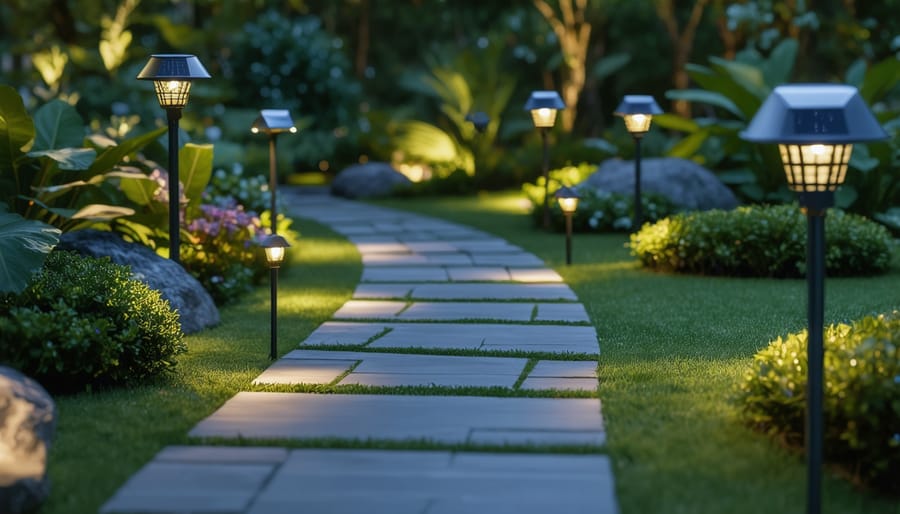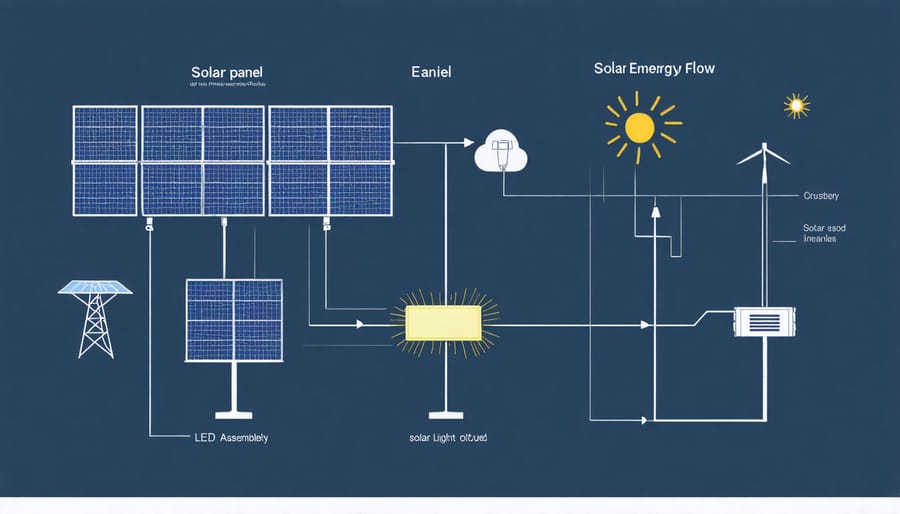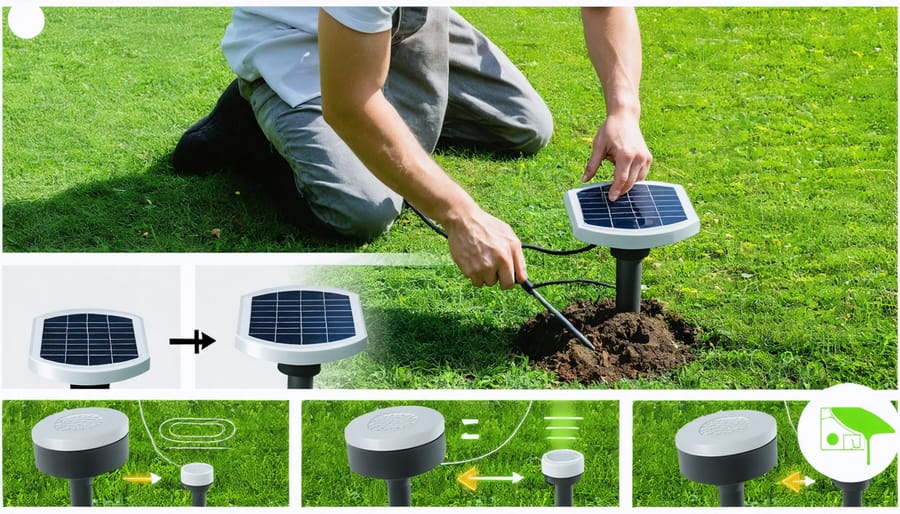Transform your outdoor space into a mesmerizing moonlit sanctuary by strategically positioning downward-facing LED fixtures high in trees, creating the same soft, ethereal glow as natural moonlight. This innovative lighting technique, known as moonlighting, casts gentle shadows through branches and foliage, mimicking nature’s most enchanting light source while providing practical illumination for evening activities.
Unlike harsh security lights or traditional landscape lighting, moonlight outdoor lighting offers a subtle, sophisticated ambiance that enhances your property’s natural beauty without overwhelming the night sky. By installing energy-efficient LED fixtures at heights of 20-30 feet, you’ll achieve an elegant wash of light that both illuminates pathways and creates dramatic depth across your landscape.
The magic of moonlight outdoor lighting lies in its ability to blend security with serenity. Modern systems can be programmed to adjust brightness levels throughout the night, reducing energy consumption while maintaining the perfect balance of visibility and atmosphere. Whether you’re hosting evening gatherings or simply enjoying a peaceful night garden, this lighting approach creates an inviting outdoor environment that extends your living space well after sunset.
What Makes Moonlight Outdoor Lighting Sustainable?
Solar Technology Integration
Modern moonlight outdoor lighting systems cleverly integrate solar technology to create an eco-friendly and cost-effective lighting solution. The heart of these systems consists of high-efficiency solar panels, typically positioned on top of each light fixture or connected through a central collection panel. These panels work throughout the day to capture sunlight, converting it into electrical energy that’s stored in built-in lithium-ion batteries.
The energy storage system is designed to be smart and efficient, collecting enough power during daylight hours to keep your lights glowing throughout the night. Most contemporary solar-powered moonlight fixtures come with advanced charge controllers that prevent overcharging and automatically adjust power consumption based on battery levels.
What makes these systems particularly appealing is their ability to work even during cloudy days, thanks to improved photovoltaic technology that can harness ambient light. The latest models feature weather-resistant housing for the solar components and can typically store enough energy to provide lighting for 8-12 hours after a full charge. For optimal performance, position your solar panels where they’ll receive maximum sunlight exposure, usually facing south in the Northern Hemisphere, and keep them clean from debris and dust.
LED Innovation
LED technology has revolutionized outdoor lighting by offering energy-efficient solutions that perfectly mimic moonlight’s gentle glow. Modern LED bulbs use up to 75% less energy than traditional lighting while lasting up to 25 times longer, making them an eco-friendly and cost-effective choice for your outdoor spaces.
The secret to achieving that perfect moonlight effect lies in selecting the right color temperature. LEDs ranging from 3000K to 4000K create a soft, white light that closely resembles natural moonlight. These bulbs provide enough illumination to navigate safely while maintaining the peaceful ambiance you’re looking for.
What’s particularly exciting about LED moonlight fixtures is their versatility. Many come with dimming capabilities, allowing you to adjust the brightness to match different occasions or times of night. Some smart LED systems even let you program lighting schedules and create custom scenes through your smartphone.
For the best results, look for LED fixtures with a high Color Rendering Index (CRI) of 80 or above. This ensures that your garden’s natural colors appear vibrant and true, even under artificial moonlight.

Creating the Perfect Moonlight Effect
Placement Strategies
Strategic placement of moonlight outdoor lighting can transform your outdoor space into a magical nighttime retreat. When planning your eco-friendly backyard design, start by mapping out key areas that need illumination.
Position downlights high in trees to create a natural moonlit effect, ideally 20-30 feet above the ground. This height allows light to filter through branches, casting gentle shadows that mimic natural moonlight. Space fixtures evenly to ensure consistent coverage without creating harsh spotlights or dark zones.
For pathways and garden borders, stagger lights at 8-10 foot intervals on alternating sides. This creates a balanced flow of light that guides movement while maintaining aesthetic appeal. Around seating areas, position lights to provide subtle ambient illumination rather than direct beams.
Water features benefit from underwater lights placed at varying depths, creating a shimmer effect that enhances the natural movement of water. For architectural elements, use grazing techniques by placing lights close to walls or structures, angling them upward to highlight textures.
Remember to consider seasonal changes when positioning lights – account for plant growth and ensure fixtures won’t be obscured by foliage. Test different angles and heights during installation to achieve the perfect balance of functionality and ambiance.

Light Intensity and Color
When planning your moonlight outdoor lighting, selecting the right brightness and color temperature is crucial to create that perfect ethereal glow. For a authentic moonlight effect, aim for lighting fixtures between 2700K to 4000K on the color temperature scale. The lower end provides a warm, inviting ambiance, while the higher end offers a cooler, more natural moonlight appearance that can beautifully enhance your home’s entrance.
For intensity, less is often more with moonlight lighting. A good rule of thumb is to use fixtures that provide between 100-300 lumens for pathway lights and 300-700 lumens for larger areas. Layer your lighting by combining different brightness levels – softer illumination for ambient lighting and slightly brighter spots for functional areas like steps or seating spaces.
Consider using dimmers to adjust the intensity based on different occasions or times of night. During early evening hours, you might want brighter lighting for activities, while later at night, dimmer lighting creates a more peaceful atmosphere. Remember that surrounding light sources, including street lights and neighboring properties, can affect how your moonlight lighting appears.
To maintain the dreamy quality of moonlight, avoid harsh shadows by positioning lights at different heights and angles. Opt for fixtures with frosted or diffused lenses that help soften the light output. This creates a more natural, moon-like glow rather than sharp, artificial beams.
Installation and Maintenance

DIY Installation Steps
Installing moonlight outdoor lighting can be a rewarding weekend project that transforms your outdoor space. Before you begin, gather your materials: LED landscape lights, weatherproof wiring, a transformer, timer, wire connectors, and basic tools like a shovel and wire strippers.
Start by planning your layout during daylight hours. Mark proposed light locations with stakes, considering areas you want to illuminate and potential power source locations. For the best moonlight effect, mount lights 20-30 feet high in trees or on tall posts, angling them slightly downward.
Begin installation by mounting your transformer near an outdoor GVCI outlet. The transformer should be at least 12 inches above ground level. Next, lay out your main cable along the planned route, leaving extra length for connections. Don’t bury the wire yet – you’ll want to test everything first.
Connect your lights to the main cable using waterproof wire connectors. Strip wire ends carefully and ensure connections are tight and well-protected. When mounting lights in trees, use adjustable mounting brackets and leave enough slack in the wire for tree movement.
Set up your timer and test the system during darkness to check positioning and coverage. Make adjustments as needed – you’re aiming for subtle, natural-looking illumination rather than harsh spotlighting.
Once satisfied with the placement, bury the main cable 6 inches deep to protect it from damage. Use conduit where wire emerges from the ground. Create a maintenance map showing wire locations for future reference.
Pro tip: Install lights in zones, connecting one area at a time. This makes troubleshooting easier and allows you to expand the system gradually as needed.
Seasonal Care Tips
Your moonlight outdoor lighting requires different care throughout the year to maintain its beauty and functionality. In spring, gently clean fixtures with a soft cloth to remove pollen and debris, and check for any damage from winter storms. Trim back new plant growth that might obstruct light paths.
Summer maintenance focuses on heat protection. Check wire connections, as high temperatures can cause expansion and loosening. Clean fixtures more frequently to remove bug accumulations, and adjust timing settings to accommodate longer daylight hours.
Fall brings unique challenges with falling leaves. Regular cleaning prevents debris buildup, which can trap moisture and damage fixtures. Consider installing protective covers on ground-level lights during heavy leaf fall.
Winter demands extra attention to weatherproofing. Clear snow from fixtures promptly to prevent moisture damage, and check that all seals remain intact. If you live in areas with frequent freezing temperatures, consider using heating tape on exposed wiring for additional protection.
Throughout all seasons, inspect fixtures monthly for water damage, clean lenses regularly, and replace bulbs proactively to maintain consistent illumination.
Cost Benefits and Energy Savings
When it comes to transforming your outdoor spaces with moonlight lighting, the initial investment pays off handsomely in both ambiance and financial benefits. One of the most compelling advantages is the significant reduction in energy consumption compared to traditional outdoor lighting systems. LED moonlight fixtures typically use 75-80% less electricity than conventional outdoor lights, translating to substantial savings on your monthly utility bills.
The longevity of modern moonlight lighting systems is equally impressive. Quality LED fixtures can last up to 50,000 hours – that’s nearly 23 years of nightly use! This extended lifespan means fewer replacement costs and reduced maintenance expenses over time. For homeowners exploring various outdoor living ideas, this durability makes moonlight lighting a smart long-term investment.
Many homeowners see a return on their investment within 2-3 years through reduced energy costs alone. The energy efficiency of moonlight lighting systems becomes even more apparent when combined with smart controls and timers. These features allow you to customize lighting schedules, ensuring lights are only on when needed and further maximizing energy savings.
Additionally, many regions offer energy rebates and incentives for installing energy-efficient outdoor lighting systems. These programs can help offset initial installation costs and accelerate your return on investment. Some homeowners report saving $200-300 annually on their energy bills after switching to moonlight lighting systems.
The environmental impact is equally noteworthy. By consuming less electricity, these systems reduce your carbon footprint while creating beautiful outdoor spaces. The minimal light pollution they produce also helps preserve the natural nighttime environment, making them an eco-conscious choice for environmentally aware homeowners.
Embracing moonlight outdoor lighting offers a perfect blend of functionality, aesthetics, and environmental consciousness for your outdoor spaces. By choosing these gentle, nature-inspired lighting solutions, you’re not just creating an enchanting atmosphere – you’re also making a positive impact on the environment and local wildlife. The reduced energy consumption, minimal light pollution, and long-lasting LED technology make moonlight lighting a smart investment for any home.
Remember that successful outdoor lighting is about finding the right balance. Start small with a few strategically placed fixtures, and gradually expand your lighting scheme as you see fit. Pay attention to how the light interacts with your landscape throughout different seasons, and don’t hesitate to adjust placement or intensity to achieve your desired effect.
As we move toward a more sustainable future, moonlight outdoor lighting stands as a testament to how we can blend beauty with responsibility. By implementing these gentle lighting solutions, you’re not just illuminating your outdoor space – you’re creating an inviting, eco-friendly environment that enhances both your property’s value and your quality of life. Take the first step today toward transforming your outdoor space with the magic of moonlight lighting.
